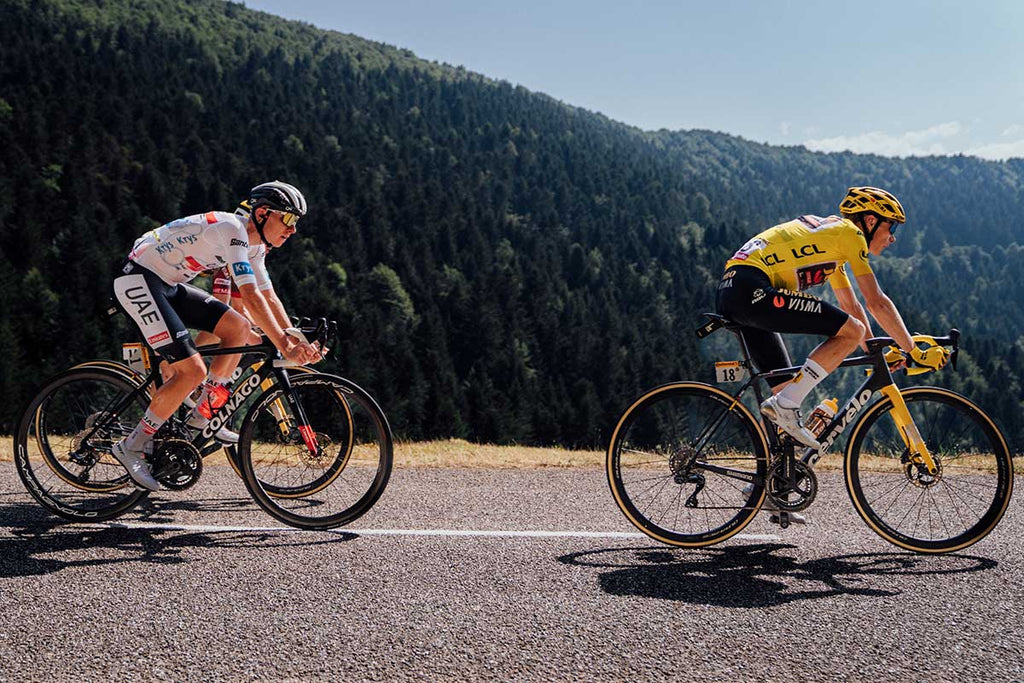The clock is running down for Tadej Pogačar
The Slovenian took his third stage win of the 2022 Tour de France at Peyragudes, but was unable to make significant inroads into his deficit to race leader Jonas Vingegaard
If you wanted a single moment that captures the narrative of the 2022 Tour de France, it might be the stinging acceleration that Tadej Pogačar made 200 metres from the summit of the Col de Val Louron-Azet during stage 17 of the race. It was exciting, showy, impromptu… and ultimately a waste of energy.
Pogačar is harrying and hassling race leader Jonas Vingegaard all the way to Paris, as he has been doing since the cobbles of stage 5. But as with his attacks on stages eight, nine, 10, 12, 14, 15 and 16, his attack on the Val Louron-Azet came to nothing. He did take a consolation stage win at Peyragudes at the end of the stage, along with four more seconds of time bonuses than Vingegaard, the runner-up, but these four seconds are the first diminution of the 2:22 lead that the Dane has stubbornly held over Pogačar since he dropped him on the Col du Granon a week previously. Other than that, Pogačar hasn’t left a mark on Vingegaard. The Slovenian has been trying to chip away at that lead almost every day since, but the attacks and digs have increasingly been chipping away at something else; the veneer of invincibility which he wore before the Col du Granon.
For the last two seasons, ever since he overturned Primož Roglič’s lead in the final time trial of the 2020 Tour de France, Pogačar has petrified his rivals and redefined the way bike races are won. He won a series of stage races, the Tour, Liège-Bastogne-Liège and Il Lombardia last year; this year he won the UAE Tour, Tirreno-Adriatico and Strade Bianche, and while he just came up short at Milan-San Remo and the Tour of Flanders, the fact that pundits were seriously predicting he could win both of them without serious blowback indicated the hold he had on cycling and his rivals. Even through the early part of this Tour, he continued laying waste to previous assumptions about energy saving and race management, attacking on the cobbles and sprinting to victory at Longwy and La Super Planche des Belles Filles.
 Image: Zac Williams/SWpix
Image: Zac Williams/SWpix
However, Jumbo-Visma and Vingegaard seem to have worked Pogačar out. He looked rampant through the first 10 days of the race, but they used his propensity to attack as a weapon against him, much like a judoka uses their opponent’s strength to throw them. By drawing him out on the Col du Galibier, and tempting him into a fight, they compelled him to try and do to them what he’d done to every other rival for two years, except he overreached. There’s no doubt that Pogačar is a generational talent with extraordinary strength, but Jumbo-Visma will not be the last team to try to use that against him. The fear Pogačar used to instil in the peloton may be gone forever.
The Pyrenees have reinforced and magnified the gaps in the GC, but the shape of the race has been clear since L’Alpe d’Huez. Vingegaard and Pogačar well ahead of everybody else, Geraint Thomas next, and then the rest of the top 10 swapping good and bad days: In Foix Bardet had a bad day and Quintana rode well; at Peyragudes Bardet bounced back and Quintana faltered. But this has been a Tour in which the logic of strength has largely prevailed at the very top: Vingegaard has been the strongest rider and is in first place; Pogačar has been the second strongest and is in second; Thomas has been the third strongest and is in third. There’s one caveat to that: Vingegaard and Jumbo-Visma used tactical nous and smart strategy on stage 11 to the Granon to create the gap between the Dane and the Slovenian in the GC, and the gap between them doesn’t represent the apparent closeness in strength since then. It’s a lesson that Pogačar might heed as he contemplates the final mountain stage of the race.
While Vingegaard and Pogačar look well matched in terms of strength, there remains the issue of the 138 seconds that still separate them. And at this point, it looks like Pogačar is running out of ideas. His UAE team rode very well through stage 17, and succeeded in isolating Vingegaard. But isolating a rider is not the same as dropping them. Vingegaard just sat safely in Pogačar’s slipstream while riders fell away at the back. The plan may have been for the attack on the Col de Val Louron-Azet to drop the Dane, or perhaps Pogačar had ambitions of attacking on the final climb, but the problem is that Vingegaard still hasn’t shown any weakness. Maybe attacking him on a climb for the 15th time after the 14 previous attempts haven’t worked will bring success but at some point Pogačar will have to address the fact that this method has not been bearing fruit.
There is still one more very hard mountain stage, a long time trial and, let’s not forget, a grippy road stage before Paris, and you wouldn’t even put it past Pogačar to attack on the Champs-Élysées. Perhaps he can do to Vingegaard at Hautacam or in the Rocamadour time trial what he did to Roglič on La Planche des Belles Filles. But the kilometres are slowly ticking down in this Tour de France, and time is running out for Tadej Pogačar. He started the Tour like Merckx, but he runs the risk of ending it like Poulidor.
Cover image: Charly Lopez/ASO






























